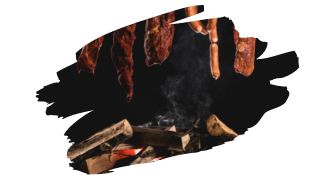If you’re serious about smoking meat, then you need to be serious about the wood you use.
That’s because it’s the wood that will dictate the deep-down flavor of your smoked brisket, pork or chicken. You see, not all woods produce the same smoky taste. In fact, some woods can actually give meat a sweeter tang than others.
So, what kind of flavor can you expect to get from smoking meat with plum wood?
Well, in this post, you’ll find out what type of wood will give meat the smokiest flavor. And you’ll also learn what kind of flavor plum wood can give to BBQ meat.

This post may contain affiliate links to products that we receive a commission for (at no additional cost to you). Learn more here.
Can You Use Plum Wood In A Smoker?
Plum wood is a fine timber for smoking with. Plum trees are fruit bearing trees, and the sweetness of this fruit comes through in the flavor it gives to meat.
Plum wood smoke adds a much more mild taste to food than more savory smoking woods, like Oak and Walnut.
Is Plum Wood That Mild? Which Wood Gives The Strongest Smoky Flavor?
If you want to give meat a really strong savory taste, then one of the best smoking woods for this is Hickory wood.
It is perfect for flavoring red meat, such as beef. However, there is a danger of Hickory wood giving meat an almost bitter flavor. Which is why you need to keep an eye on the temperature of the smoker.
So, keep the temperature low, and smoke the meat for a little bit longer, to avoid it becoming bitter.
Nevertheless, when it comes to plum wood, this particular timber isn’t anywhere near as strong as Hickory wood. It is much more mild, making it better suited for meats such as chicken and fish.
Is It Safe To Use Plum Wood? What Kind Of Wood Should You Not Use In A Smoker?
Avoid using any type of wood that has a lot of sap or pitch in it. That resinous sap/pitch will vaporize as you burn those chunks of wood. And that sap/pitch will end up infusing into the meat (along with the smoke).
This can give your food a weird taste. What’s more, if enough sap/pitch infuses into meat — and you consume it — it can even make you ill.
Regardless, in the case of plum wood, this particular tree doesn’t produce an abundance of sap/pitch.
What Is Tree Sap And Pitch? Well, tree sap is a substance that trees produce to fight off bug attacks. While tree pitch is a natural resin that trees secret to seal over damaged parts of their stem.
What Is The Mildest Wood For Smoking Meat With?
Smoking woods that come from fruit-producing trees give food the mildest flavor.
So, woods like cherry, plum and apple wood add a subtle flavor to meat.
Can You Mix & Match Plum Wood For Smoking?
You can absolutely mix different smoking woods to tailor to your own tastes.
For example, a mix of 2/3rd plum wood with 1/3rd Hickory wood is great for smoking pork ribs. The sweetness of the plum wood will take the edge off the strong flavor of Hickory wood.
And How Do I Make Plum Wood Smoke Better?
For the best smoking wood, you need to give it enough time to season, before you use it.
You see, wood that hasn’t been seasoned will produce too much smoke, and end up over-smoking your BBQ meat. And all of that excessive smoke will end up making that meat taste bitter.
How Can You Tell If Plum Wood Is Seasoned Enough?
It can take anywhere from 6 to 12 months for wood to season and dry out. But, there are a couple of quick ways to check if wood is ready to smoke with;
A). Does It Sound Hollow?
Knock a couple of the wood chunks together. If they make a hollow dull sound, then that wood is dry enough to burn.
B). Does It Smoke A Lot?
Simply take a small chunk of plum wood, and burn it. If it starts bellowing out a lot of smoke, then it’s still too wet to use.
Related Post: How To Season Wood (7 Tips)
To Wrap Up, Here Are The 3 Key Takeaways From This Post…
- 1). Plum wood will give meat a mildly sweet flavor.
- 2). This mild smoking wood goes great with chicken and fish.
- 3). To smoke pork ribs, you can mix plum wood with hickory wood.
References:
Husbands, A. and Cranford, S., 2019. A material perspective of wood, smoke, and BBQ. Matter, 1(5), pp.1092-1095.



